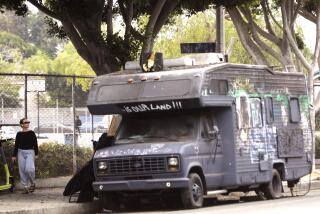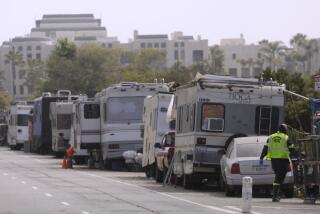Why the motorized toys we love keep getting bigger and bigger and bigger and BIGGER
- Share via
On “The Simpsons,” Marge recommends driving into the wilderness in the fictional Canyonero, an SUV that is “12 yards long, two lanes wide, 65 tons of American pride.” Exaggeration? Maybe not. Domiano RV’s in Orange County sells the Travel Supreme ME -- a 41-foot luxury coach that has a built-in “garage” big enough to carry a Mini Cooper in its belly.
Only two Travel Supreme MEs have been built so far, but Chuck Cooper, a salesman at the Stanton dealership, says they’ve had plenty of interest in the vehicle. There’s only one problem -- it’s too big for campsites in most state and national parks. In fact, many of the recreational vehicles on the market are too big for the parks. Parks, Cooper says, “just haven’t kept up with the times.”
The go-for-broke trend toward bigness has been most conspicuous on the highway, with half the new cars sold in California being Hummers, light trucks and sport utility vehicles. But a similar trend toward super-sized motorized toys is sweeping campgrounds and lakes, snowy mountains and desert sand dunes as well.
Today’s top bass boats are loaded with electronic gadgets and propelled by 250-horsepower outboards: engines as tall as a man, as powerful as a sports car and capable of going faster than 80 mph -- and on water, that’s fast. “Personal” watercraft have become interpersonal water rockets that seat a family of four and carry price tags approaching $10,000.
Some houseboats resemble ferry boats. The biggest ones, at 75 feet long and 22 feet wide, require four months just to secure permits to transport across highways and require police escorts on the way to water. At Lake Powell, a behemoth called “Big Dog” is three stories tall, has twin diesel engines, multiple staterooms and cranes to load Jet Skis. Cost: $6.7 million.
“People see the size of these things and say they’re bigger than my house. In fact, everything you’d want in a house, these boats have. Some have hot tubs, freezers and satellite TV. There’s nothing you have at home that you don’t have in your houseboat, except a garden,” says Len Cook, president of the Marine Merchants Assn. in Page, Ariz.
The four-wheel-drive Dodge Durango, redesigned for 2004, is now 7 inches longer and 3 inches wider, with a 330-horsepower Hemi engine -- 100 horsepower more than last year’s model, says Rick Deneau of DaimlerChrysler AG. Ironically, the Durango is considered a “tweener” vehicle, one that lands between classes and is short of being classified with the largest SUVs.
*
Home on the road
The trend in RV manufacturing is to provide more room by creating sections that roll out once the vehicle is parked. The Travel Supreme Diesel Pusher has an optional “exterior entertainment center” unit that pops out of its side. Coaches can’t get much bigger or they won’t fit in an average highway lane, says Ron Epstein, a spokesman for the Ventura-based Good Sam Club, the nation’s largest RV owners’ organization.
“I saw an amphibious motor home at a show recently. If I hadn’t seen it I wouldn’t believe it. They have motor homes with plasma TVs, satellite TVs and most of them have mini-offices set up with phone port and desks,” Epstein says. “People love the idea that they can go to Yellowstone and still watch the Dodgers.”
While the vehicles are bigger and faster than ever, some campers complain that they’re also increasingly obnoxious. More muscular machines make the outdoors more accessible to more people, but they also change the nature of recreation and human interaction with the environment, critics say. Just as McDonald’s recently decided to drop its super-size menu options, so too is a backlash forming against gargantuan outdoor vehicles.
Ray and Susan Starbucks met through the Sierra Club and have visited Yosemite National Park nearly every summer during their 28 years of marriage. The drone of RV generators bothers them. Besides, Ray Starbucks argues, the machines the mini-power plants enable, from air conditioners to microwave ovens, “have no place in the outdoors.”
Not that the Starbuckses are purists. Now in their early 50s, the couple left their backpacking days behind and went retro with a GMC 1500 pickup truck and camper. They use a solar panel to recharge batteries.
“There are people who would never see it [the outdoors] at all without an RV, but the crowds have increased constantly and we hate the noise of the generators,” Susan Starbucks says. “Both of us find [oversized RVs] a little ridiculous. You can’t really call it camping, it’s just living.”
The new giants add more than decibels to the recreational realm. Bigger machines powered by high-octane engines mean more mass in motion. That can lead to death and injury.
Today’s outboard engines average 85 horsepower, 30% more than 14 years ago, according to the National Marine Manufacturers Assn. There were 750 boating-related fatalities in 2002, the most recent figures available from the U.S. Coast Guard. Half the boating fatalities in California occur in lakes and along the Colorado River.
All-terrain-vehicle accidents killed 357 people in 2002, up 67% in five years, according to the Consumer Product Safety Commission. Many thousands more were seriously injured, and children under 16 accounted for half the injuries. The Tri Moto, the first ATV introduced by Yamaha Motor Corp. in 1980, had a 123-cc engine; Yamaha’s 2002 Grizzly has a 660-cc engine.
To the litany of complaints about the bloating, add pollution: The big generators that power gadgets on houseboats spew enormous amounts of carbon monoxide, a potentially lethal gas, beneath the vessels. At least 482 boat-related deaths by carbon monoxide poisoning have been reported since 1990, including many at Lake Powell, according to federal investigators.
Yamaha’s first snowmobile in 1968 was powered by a 20-horsepower engine; its new RX Warrior has a 145-horsepower engine, bigger than the motor of a Honda Civic, though the snowmobile is much smaller and lighter. Which may help explain why in Yellowstone National Park, snowmobiles emit so much pollution the EPA has recommended banning them and rangers working at the park entrance wear gas masks to protect themselves from the noxious fumes.
*
A security blanket
John K. RUSSELL, a Long Beach psychologist and RV owner, says size matters in the American psyche.
“In the wild, animals puff themselves up so they look bigger and more ferocious when they believe they are threatened. People do the same things to make themselves feel secure and protected by surrounding themselves with a big SUV or RV. Manufacturers know this and build their RVs bigger hoping to attract buyers,” Russell says.
Russell learned the importance of size when he rented his 37-foot motor home to a film company. “The star on the film had a clause in his contract that said his RV had to be the biggest on the set,” he says. “Turned out mine was longer so they made me take it away.”
Some in the RV industry say the current boom was triggered by the events of Sept. 11. People have apparently decided that “bunkering” is the way to cope with an unsafe world. The RV is becoming their bunker -- a very comfy shelter with all the conveniences of home. RV sales are up, totaling 330,100 units annually and $12 billion in sales.
More than luxurious and powerful, the machines offer autonomy, says David Woodworth, a historian for the Recreational Vehicle Industry Assn. He predicts bigger vehicles. The trend, he says, reveals a wonderfully American trait.
“RV-ing,” he says, “has been so popular for so long because it fills one of the most basic human needs -- freedom.”
*
Philip Reed is an editor at the automotive website Edmunds.com.
More to Read
Sign up for The Wild
We’ll help you find the best places to hike, bike and run, as well as the perfect silent spots for meditation and yoga.
You may occasionally receive promotional content from the Los Angeles Times.






